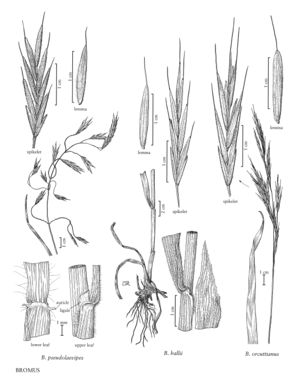Difference between revisions of "Bromus orcuttianus"
FNA>Volume Importer |
FNA>Volume Importer |
||
| Line 38: | Line 38: | ||
|publication year= | |publication year= | ||
|special status= | |special status= | ||
| − | |source xml=https://jpend@bitbucket.org/aafc-mbb/fna-data-curation.git/src/ | + | |source xml=https://jpend@bitbucket.org/aafc-mbb/fna-data-curation.git/src/f6b125a955440c0872999024f038d74684f65921/coarse_grained_fna_xml/V24/V24_295.xml |
|subfamily=Poaceae subfam. Pooideae | |subfamily=Poaceae subfam. Pooideae | ||
|tribe=Poaceae tribe Bromeae | |tribe=Poaceae tribe Bromeae | ||
Revision as of 19:15, 24 September 2019
Plants perennial; not rhizomatous. Culms 90-150 cm, erect; nodes 2-4, pubescent or puberulent; internodes glabrous to pubescent, pilose to densely pubescent below the nodes. Basal sheaths sparingly to densely pilose, hairs 2-4 mm, occasionally glabrous; upper sheaths hairy, hairs to 1 mm, collars glabrous or pilose, hairs to 4 mm; auricles absent; ligules 1-3 mm, usually glabrous, occasionally pilose, obtuse, erose; blades 7-24 cm long, 3-12 mm wide, flat, usually glabrous, sometimes hairy. Panicles 7-13.5 cm, open; branches erect, ascending and appressed to slightly spreading. Spikelets 20-40 mm, elliptic to lanceolate, terete to moderately laterally compressed, with 3-9(11) florets. Glumes usually glabrous, occasionally scabrous or pubescent; lower glumes 5-9 mm, 1(3)-veined; upper glumes 7-11 mm, 3(5)-veined, sometimes mucronate; lemmas 9-16 mm, elliptic, rounded over the midvein, backs usually pubescent, sometimes glabrous or scabrous, margins pubescent or scabrous, apices obtuse, entire; awns (4)5.5-8 mm, straight, arising less than 1.5 mm below the lemma apices; anthers 3-5 mm. 2n = 14.
Distribution
Calif., Ariz., Oreg., Nev., Wash.
Discussion
Bromus orcuttianus grows on dry hillsides and rocky slopes, and in open pine woods and meadows in the mountains, from 500-3500 m. It is found in the western United States, including Washington, Oregon, California, Nevada, and Arizona. It is not known from Mexico.
Selected References
None.
